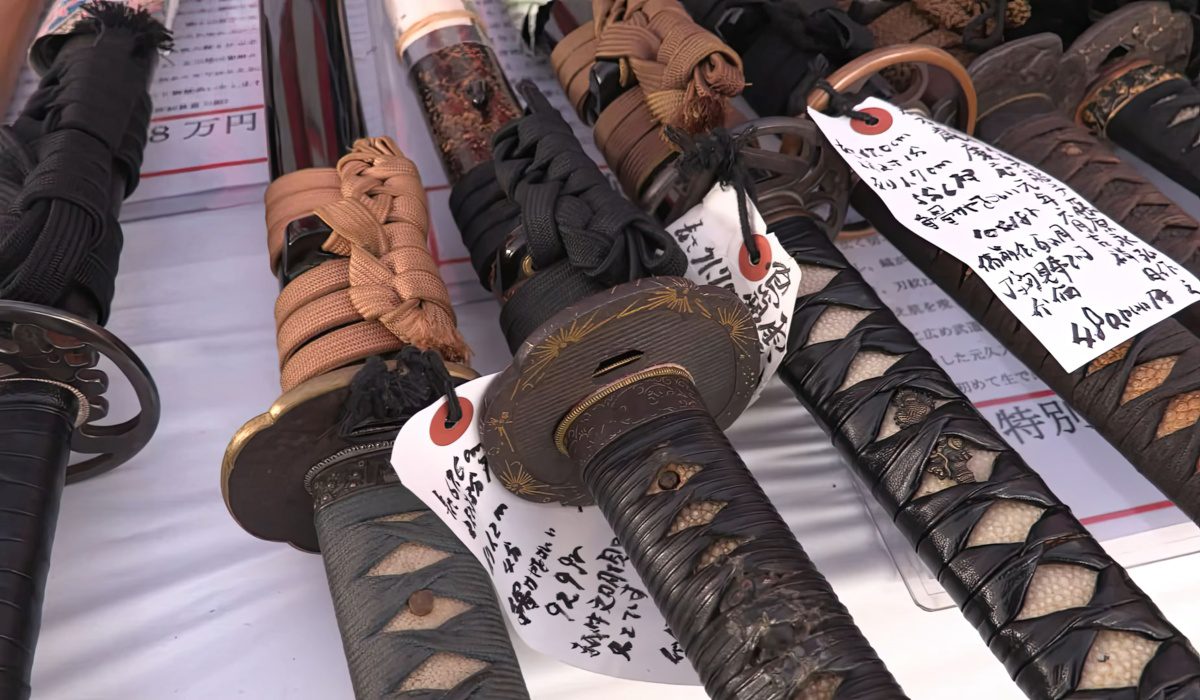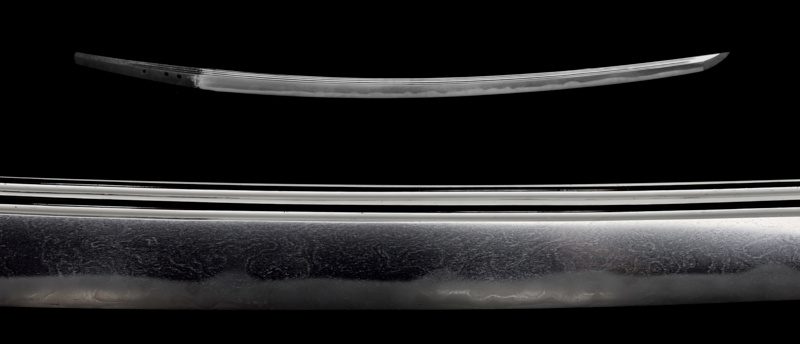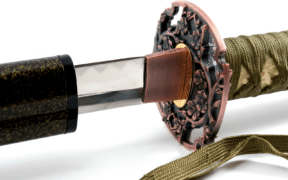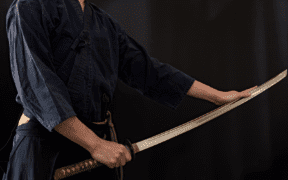Real Katana Prices Explained: How Much do They Really Cost?
NO AI USED This Article has been written and edited by our team with no help of the AI

The price of a katana sword is influenced by various factors, including whether it is a replica, a newly-made nihonto (authentic Japanese sword), or an antique. Real/Authentic Katana swords are available at various price points, ranging from $8.000 up to $200,000 or even more in rare cases.
Traditionally-made ones by licensed swordsmiths in Japan can be quite expensive and valued on their own merits. On the other hand, replica katanas for practice or display purposes are more affordable.
Replica Katana Prices
The replicas are often machine-made with a single steel type but can include details like a hamon and customized sword mountings.
Katana replicas are categorized into three price ranges: $60-$150 for decorative swords made from lower-quality materials; $150-$500 for medium quality replicas suitable for iaido and some cutting practices, made from more durable materials; and $500 – $4,500 for higher-quality replicas that vary in material and tempering but may not have the complex construction of authentic katanas.
There is a price gap, approximately between $4500 and $8,000, where it’s challenging to find many NEW katanas. If you do find them, they are either too expensive for a replica or too cheap for an authentic katana. Based on our intensive research, Z-Sey Swords offers some of the priciest replicas. However, they are the closest thing you can get to an authentic katana.
Newly Authentic/Real Katana Prices
$8,000 or higher (Made by Young Smiths) – Katanas in this group are often newly-made swords (nihonto) by young smiths. In Japan, swordsmiths have licenses and practice sword making as a means of cultural preservation. Under governmental regulations, each swordsmith can produce a maximum of two long swords, such as a katana or tachi, or three shorter blades, such as wakizashi or tanto daggers, per month.

$50,000 or higher (Made by Famous Smiths) – This price point oven features newly-made katana swords (nihonto) made by famous smiths. As previously mentioned, swordsmiths are restricted to producing only two long swords monthly.
Therefore, the considerable cost is due to the limited production of katanas that are often in high demand and a limited supply of blades made by top swordsmiths (Mukansa level and above). These blades are also valued for their exceptional artistic qualities.
Antique/Old Authentic Katana Prices
$5,000 – $50,000 (Made by Less Famous Smiths) – For antique katana swords (nihonto) made by less famous smiths, there are some relatively less expensive swords that may have flaws due to age or use, diminishing their value.
While some flaws may be overlooked or repaired, others can be fatal. Ideally, these swords must have appraisal papers from reputable organizations in Japan about their quality and value.
$200,000 or higher (Made by Famous Smiths) – At the highest end are antique katana swords (nihonto) made by famous makers. Many of these are representative or typical works of a particular smith, school, or province in which they were produced. Their uniqueness and historical significance contribute to their high price.
To further authenticate their quality and value, these antique katana swords ideally come with appraisal papers from the Nihon Bijutsu Token Hozon Kyokai (NBTHK) or the Nihon Token Hozon Kai (NTHK). These appraisal papers will confirm the sword’s authenticity, provenance, and quality.
Factors That Impact the Price of a Katana
Traditionally-made katana swords (nihonto) crafted by Japanese swordsmiths are held to high standards and valued based on factors such as the maker, age, origin, condition, and quality. On the other hand, katana replicas vary greatly in their material, construction, tempering, and purpose, which directly influence their cost.
1. Swordsmith

The value of newly-made katana swords is influenced by the swordsmith’s ranking. Rankings are often determined by the awards from annual competitions held by the NBTHK (Society for the Preservation of Japanese Art Swords).
To determine a katana’s fair price, it’s essential to compare swords from similarly ranked makers. However, a swordsmith’s ranking doesn’t always reflect consistent quality. Katanas that differ from a maker’s usual style may be less valuable than those exemplifying their standard craftsmanship.
2. Antique or Newly-Made
Old or antique katana swords, particularly those attributed to famous swordsmiths or historical periods, can be exceptionally valuable and more expensive than newly-made ones. Generally, old and antique katana swords undergo shinsa (formal sword appraisal or examination) to establish their authenticity and quality.
Official organizations in Japan, such as the NBTHK and NTHK (Nihon Token Hozon Kai), assign designations to swords based on their qualifications. These designations play a crucial role in determining the pricing of a katana. Often, old katana swords that represent a swordsmith’s typical work come with appraisal papers.
3. Quality and Condition
The quality of a katana sword is not always determined by its age. Flaws (kizu) may be present in a blade, whether resulting from forging or heat treatment. Some flaws, such as bends, cracks, and chips, are a result of their use.
Occasionally, a blade may have lost its hardened edge in a fire and been re-hardened later, resulting in it no longer being original.
While not technically considered flaws, alterations to the tang, reshaping of the blade, or shortening of the blade can affect the value of a katana.
As a general rule, flaws, if present, should not diminish the functionality and aesthetic value of the blade. Antique katana swords (nihonto) typically come with appraisal papers from the NBTHK and NTHK, providing information about their value and quality.
4. Blade Material and Construction
Traditionally-made katana swords (nihonto) are often crafted from tamahagane and feature a complex blade construction, giving the sword its strength, durability, and resistance to breakage.
For example, a katana blade may consist of soft core steel (shingane), a harder steel jacket (kawagane), and a sharp edge steel (hagane), each with varying degrees of hardness.
On the other hand, katana replicas often utilize a single type of steel, usually high-carbon steel, medium-carbon steel, or spring steel. Some steel types may also incorporate elements like manganese, chromium, and silicon to enhance rust resistance or improve toughness and hardness.
5. Tempering

The unique differential hardening process of Japanese swords (nihonto) produces a distinct hamon pattern along the cutting edge. The hamon indicates that the swordsmith hardened the cutting edge more than the rest of the blade, optimizing its effectiveness as a weapon.
The hamon also helps limit the size of nicks and damage the cutting edge may have during use. More than that, a hamon gives an artistic value to the katana blade.
Many katana replicas strive to recreate a real hamon with clay-tempered blades. With proper heat treatment, these replica blades can be suitable for test-cutting practice (tameshigiri) and may be considered battle-ready.
However, many katana replicas only have acid-etched or stenciled hamon, which does not contribute to the functionality of the blade.
6. Sword Mounting

Japanese katana swords (nihonto) can be mounted in a shirasaya (plain wooden scabbard) and equipped with a habaki (blade collar). However, a complete functional mounting, known as koshirae, generally increases the price of a katana.
Koshirae consists of a lacquered scabbard (saya), a sword guard (tsuba), and various components of the hilt (tsuka), such as fuchi and kashira (metal collar and pommel cap).
A katana‘s hilt (tsuka) is often covered with ray skin and features a braided hilt wrapping (ito). It is also adorned with menuki ornaments on each side of the hilt and a sageo cord for securing the scabbard to the belt.
Koshirae crafted by Japanese artisans are handmade, high quality, and have superior craftsmanship, making them more expensive. On the contrary, replicas are mass-produced yet often offer good quality at a lower price point.





